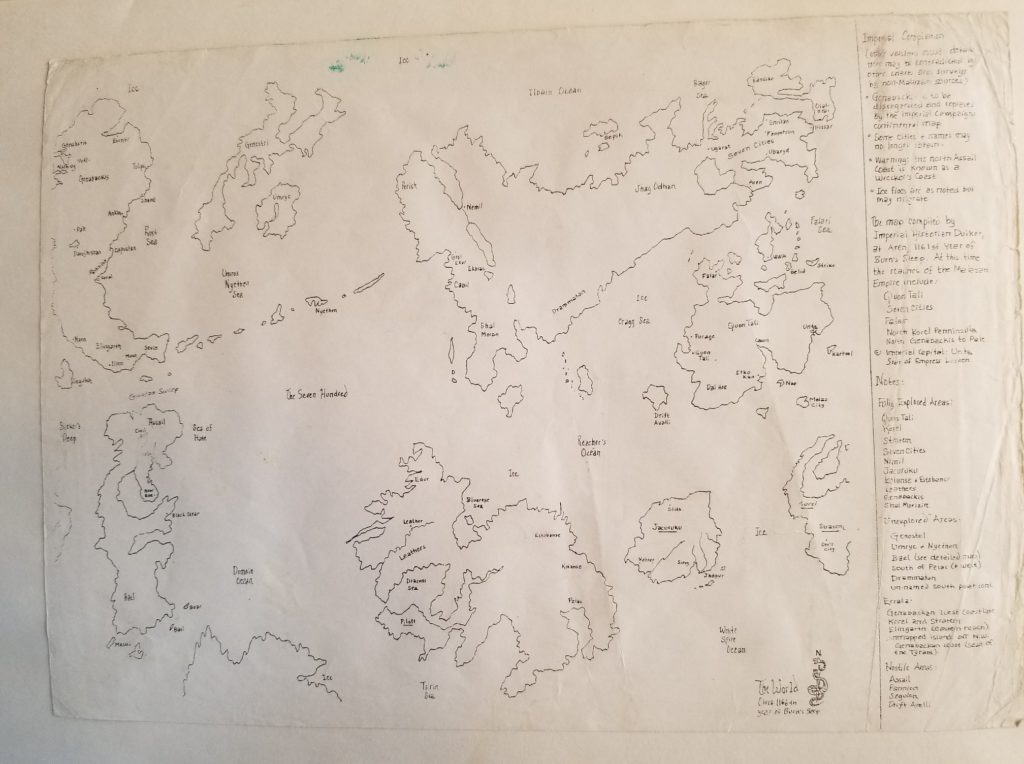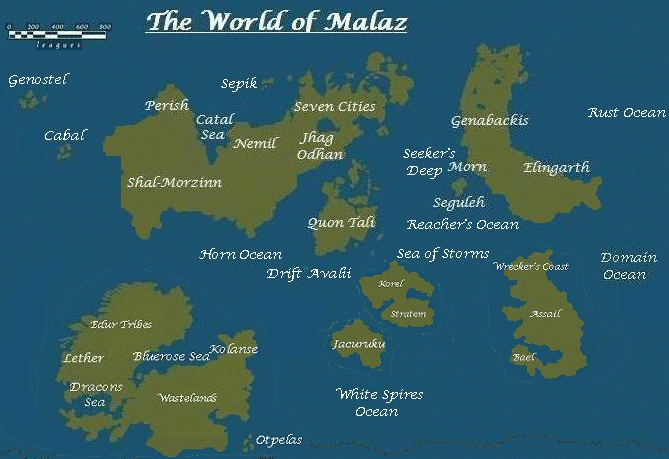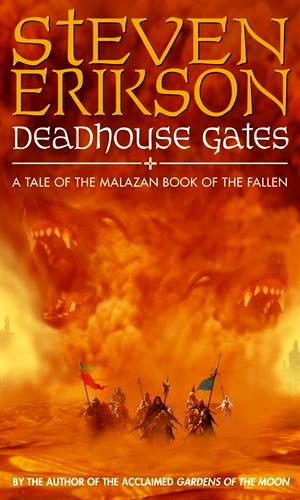 Deadhouse Gates is the second volume in the “Malazan Book of the Fallen” ten volumes (now sixteen) planned series. The eighth, Toll the Hounds was recently released in UK.
Deadhouse Gates is the second volume in the “Malazan Book of the Fallen” ten volumes (now sixteen) planned series. The eighth, Toll the Hounds was recently released in UK.
I finished the first book wanting more, while this one left me tired and drained. It’s a demanding read, denser and deeper than the first volume. I let a few days pass to write some comments because I wanted to figure out some parts. The border between awesomeness and mediocrity is incredibly thin, this is another book that asks the reader a lot of faith in the writer. Erikson delivers, but in many cases that faith is put at risk and I can easily understand why some readers come to hate this series.
For me this second book is difficult to judge because the last 200 pages went in a direction I didn’t like at all, so that conclusion undermined and made be doubt retroactively of the whole thing. Outside that particular aspect I loved the book. Without that questionable conclusion I would consider it the very best fantasy book I read, far above all the rest (even if I don’t have this huge experience in the genre, so my superlatives are relative). It’s interesting to consider the sharp turn represented by those last pages because of various reasons. The first is that in my opinion the quality of the writing and the style are worse than in the rest of the book, more forgettable, less imaginative, too rushed. On the other hand the majority of readers love the ending, so this is a contrast of my opinion versus the consensus.
It’s interesting to consider this dynamic because of how it is repeated. There’s a part in the book not only exceptional on its own, but that delivers one of those powerful epiphanies that makes so many pieces of the puzzle come together in a smooth way, all at once, all in the mind of the reader. You drop the book and the mind does the rest, and this out-of-text experience is so much more interesting than the usual passive reading. Not only there’s the satisfaction coming out of it, but a lot of parts that made no sense in the first book are suddenly well motivated,. It’s a so charming experience that made me retroactively appreciate the first book much, much more, as it is immensely satisfying to go back and find obscure parts of the text that acquire a completely new meaning and relevance. Sleight of hand, wonderfully realized in this case.
So you can imagine how much I was pissed when by the end of the book all those theories fell apart. Erikson fills your hands with broken pieces that look like useless garbage, you wonder why. Then with perfectly executed sleight of hand he makes you realize out how the pieces match, and the emergent, beautiful result. You spend a lot of time admiring that, repeating to yourself how cool Erikson is, and then he kicks it and sends pieces in all directions. What you get is another pile of garbage. And this time it looks very unlikely that things will come together again. It just can’t happen. My trust in the writer went down at the point. Sure, if he’s able to take those pieces and repeat the trick without contradicting every other part of the text then the outcome would be even more awesome than the first go. But I don’t see how it is going to happen. I finished the book with that skeptical eye. The thin line separating awesomeness from mediocrity. A matter of trust, sure, but also a matter of *earning* that trust. Building trust throughout the book, to then shatter it to the end isn’t the best strategy if you care about the reader. Rather risky. Success or failure? Genius or amateur?
Consider, though, that this whole dynamic happens out the text. Especially because it’s all about making sense of the first book, and the theme itself isn’t touched in this second book. So all this speculation only comes if you are actively doing it yourself, but it isn’t part of the text or theme of the book. And as it often happen the speculation is only fun if your trust it is motivated and well founded, because if you discover that you only imagined the whole thing yourself, well, it sucks. Not only it ruins that moment, but also everything that came before.
The ambivalence contained there explains how it’s hard to judge the book. High stakes. Either it goes one way or the other. And you see it stagger a lot.
Suspending the judgment on these out-of-text considerations, there are other aspects I didn’t like and that don’t have similar justifications. Two of the storylines are rather badly told in those last 200 pages. One is about Fiddler and company arriving at the Azath and the other about Kalam arriving at Malaz Bay. From that point onward I thought the writing was weak and redundant. There are a number of repetitive fights that could be spared to the reader (if the reader expects more from a book than some cheap action scenes) and that are ALL resolved through a number of unmistakable “deus ex machina”. So there is: redundancy, lack of originality, and the break of the suspension of disbelief as scenes are resolved too many times through artificial last-minute savings. You can imagine how this all felt like if I suddenly was reading a wholly different book as it contrasts sharply with the grittiness, bleakness, dryness (in a good way) and realism of the rest of the book.
I also didn’t like those scenes from the stylistic point of view. Battles between rats, bears and flies. Bleh. It isn’t imaginative and the ordinariness kills for me the “epic”, fascinating atmosphere. I’d expect something more original and cool looking, instead it feels like a zoo. Same for Kalam versus the ninjas. Like a bad b-movie. When Erikson uses conventions he usually spins them in some original, unexpected ways. That whole part with the ninja fight instead it’s just deja-vu, predictable and cheap. And in both cases those are battles thrown in the book just to offer some badly described action scenes. Like if it went from a movie with a soul, to some Hollywood summer movie. There were some similar scenes even earlier in the book that didn’t annoy me, but when at the end of the book you get one after the other, endlessly, well, it’s too much. The redundancy is boring and kills completely both the interest and the sense of urgency and danger that the writer wants to push, and fails there. Then the insisted and unforgivable use of “deus ex machina” to resolve those scenes give it the last stab. Bah, from Erikson I expect (and was taught to expect) way, way more.
I’m underlining here how bad is the last part also to explain how good are the previous 700 pages (and more, since of those 200 only those two storylines are bad, while the rest is consistent through the very end). Far, far past my hopes and expectations. I knew that the first book was considered the weakest and this second one the second best just behind Memories of Ice, but still the very best for a lot of readers. Now that I’ve read the book I can say I agree. They all said the writing and structure was improved compared to the first book, but they didn’t explain how much. From an objective point of view, the execution is immensely improved on every aspect. Structure, pacing, characterization and, in particular, the writing itself.
If you read the first book and hated the style, this second one probably won’t make a different impression. It’s the same style, but executed much better. I could understand if someone said the first book was entertaining, but made hard by the writing. In this other case not only the writing doesn’t get in the way, but it’s one of the first reasons why I loved reading it. It’s so evident that Erikson matured and is trying to push the bar up instead of merely trying to reach a quality level. The first ten pages of the prologue are some of the best I’ve ever read in fantasy. A masterpiece. The second part of the prologue is actually more spectacular and bloody, but those first ten pages are genius.
One of the biggest and easy to recognize differences between modern and classic writing is how today television and cinema influenced it. We have descriptions that imitate cameraworks, action scenes that reply the blurring, slo-mo, zooms, dollys, fly-bys. The language continually changes and mixes between mediums, and Erikson isn’t stranger to this. Gardens of the Moon was born as a screenplay and it’s filled with tricks belonging more to the cinematographic language than literature. For example how he plunges you in the bloody aftermath of a huge battle, only to show the battle itself a moment later, through a flashback. Erikson loves to play with these tricks and keeps a creative approach to the way things are presented and how the plot is structured. What makes those ten pages of the prologue so special is that he does one brilliant trick that is impossible with the cinema and that is pure “literature”. So not only he is aware of how the language changes, but he is also able to take the best from both and use all that creatively.
I’ll explain. Those first ten pages simply describe a priest of Hood, shrouded in a mass of flies, walking down a path toward some chained-in-a-row slaves. Among those slaves there are a few new characters presented, and Felisin, someone who never appeared in the first book but that was still introduced and closely related to one major character (being Paran’s sister). Now, if this was a movie scene you would imagine an “eye” that fixes and follows this horrific hump of flies approaching the slaves. You would see right there who are the slaves, who are the guards. The characters speak, you see where they are and guess their roles. The “image” presents and delimits them, the scene defined. But this is instead *written* text, you don’t have to expose and spoil as much. You can select what to expose and what is eluded. The “eye” indeed follows the priest of Hood, is witness of the reactions of the guards, and then moves to the reactions of the other characters. Felisin and Heboric, one of the slaves. The attention is focused on the reactions they have toward the priest of Hood, the reader’s attention there as well. But the surprise that comes later and that is the pivot isn’t about the priest and its role. But it’s in the revelation that Felisin too is a slave, chained to Heboric and Baudin. That came as a bit of a shock to me because I didn’t expect Felisin there in that role. I imagined her among the guards, or just as an onlooker in the scene. The “trick” was about playing with the “unwritten”, deceiving the reader to think of a situation, only to reveal a moment later with something akin to a chill that one of the characters already introduced and active wasn’t an external observer, but one of the “victims”. A sudden overturn that also makes you go back a few pages and reconsider the whole situation. Coupled with a mystery (the Hood’s priest and weird things he inspires) that is chased and replaced by an even more powerful one (the purge and subplots related to Tavore and Laseen).
This is why I loved this book and also an example of something that defines the whole Malazan series. The misleading, the reversal, the retrofitting, the, once again, sleight of hand. Erikson doesn’t simply tell an interesting story, but he invents and executes skillfully all sort of interesting tricks. He isn’t simply master of *what*’s written, but, especially, *how* it is written. And for me that’s essential in reading a book. I need a certain use of language that grips my attention. He writes these huge tomes in ten months, you expect the writing being perfunctory, with all attention focused on what’s written and the tangles of the plot, but Erikson also plays with the structure and the execution, and there is no trace of rushed work. He dares and pushes a lot, is immensely creative at different levels. He knows he’s writing a *book* and he takes advantage of everything written words can do and that is unique and different from other mediums. Today everything is a blur. Books become TV, movies, games, songs. Nothing is really circumscribed. Erikson doesn’t simply write something cool, but he fully understands and exploits the specific medium he is using.
In that prologue he continues to amaze. One bigger wonder stacked on top of the previous. First the priest, then Felisin revealed, the the politics about the empress, then the introduction of a character that wouldn’t fit better: an historian. And not just a normal one, but an heretic, knowing things that cannot be said and that remained a longed mystery throughout the first book. In that moment you crave for answers and Erikson hides them within an heretic historian, the figure that can tell you all you want to know, making you cling to everything he says. Gripped. And when you are there, longing for more answers and revelations, a total mess explodes in a climax and steals your attention. That’s how you hook a reader, but with the downside that those hooks are subtle, and only effective if you are paying attention and “wanting”. The risk is that instead of being hooked, you’re just confused. Erikson doesn’t lead by hand nor spoon-feds, and if you’re lost, he doesn’t look back to help. In a way, he is akin to Gene Wolfe. He says things only once, and the important ones don’t even stick out. Either you are quick to jump on the train, or the train departs without you.
On the matter of structure, this book is easier to digest compared to the first. The groups and characters that have a part in the novel are still present in staggering numbers, but mostly grouped around four main storylines that proceed separately. So easier to follow as for most of the book they stay delimited and don’t overlap. But this is also one of Erikson’s most successful ploys as he persuades you to think within bounds, only to discover later the subtext. How everything is actually linked, how layered and filled with allusions to what comes later is the text. Sleight of hand. Masterfully executed, but only for the attentive reader.
This is not just about foreshadowing, it’s not one-directional, but it also goes back, as history and myths here have active roles. They are alive and actual. The fun is in those nuances that are easily missed by the distracted reader. You need a trained mind to make a sense of the different levels, the personal character’s issues amid the overarching plots, the web of plot threads. Erikson demands attention, and by demanding attention he also takes the risk of failure, as explained above. The ambivalence and risks that come with the ambition.
This “device” is also interesting because of its two different uses. The first for structure and pacing, the second as build-up. The convergence as a concept. Thematic and stylistic. Usually in fantasy novel the party starts together (in a small “corner” of the world to better present the story and make it the “escalate” toward epic), then splits up. This creates that alternation where one chapter follows a group and the following another, so that expectations are made and the reader hooked. Erikson spins that concept and uses it in a stronger way. Storylines start separately, but you know that everything will come together later on. This not only gives structure to a big novel (the alternation of plot threads), but it works well to “accelerate” toward the end of the book. Toward an explosive cliffhanger.
An interesting theme in the book is about the relationship with the gods. This was already touched in the first book, but is here greatly expanded. While the first book only looked at certain specific aspects, in this one the theme is observed from all the perspectives possible. What happens in a world where the existence of gods isn’t just assumed, but proven? The first consequence is that those gods are “questioned”. In our world people can be classified between believers and unbelievers, with various degrees. But if you believe, then you try to follow what the god says the best you can. If you don’t believe, you don’t. The only distinction is about believing or not. In Erikson’s fictional world “unbelievers” are uncommon. Gods’ existence is taken as granted, but it’s because of this that the theme is richer. What if the god is lying to me? What if he’s using me? What if the god is selfish? And so on.
In the case of the book people are suspicious of their gods. There’s a hint of desperation as the relationship is one of subtlety and power. And even more interestingly, gods’ presence is always in the air. Perceived but never sure. So we have both the perspective of gods as real, interfering entities, and gods as “impalpable” presence. Both the certainty and the uncertainty. It’s even more faceted and complex than how the real world is perceived. This is not just an original idea thrown in the book like many others. It’s instead an anthropological device that strongly impacts the cultures of that world and influences the way people think and behave. It all links to one strong skill of Erikson about the “worldbuilding”. Not simply the complexity and number of elements, but about how deep they go and affect people. About how strongly the fictional world is made “real”, while also different than ours, while also tightly connected. A way to explore humanity from unconventional perspective. All this wonderfully realized.
I’ve read recently that Erikson complained his readers care too much about the facts and plots, while he hoped that the focus was actually on the themes explored. This can be perceived in the book. The characters are vehicles of emotions and strong themes. What happens is a way to explore those themes. The plot is only “enabling” to reach that point. As Erikson himself explained, the fantasy genre allows to make a metaphor real. Experience things without filters. It’s not a case that the characterization in this book is so much stronger and deep. Not only some characters are delved inside, but they also evolve in unexpected ways. In directions that are rather daunting. So not just a matter of all around, deep characters, but also the way what they are and what they live makes them change and become something new, to the extreme consequences.
Something similar can be said (and it’s actually illuminating) about those scenes with the lapdog. I bet those who read the book are already chuckling. When I read the last scene of the Chain of Dogs I thought that Erikson had outperformed in epicness everything epic till that point. It’s not about the scale. Big armies, big battles, big dragons, big explosions, thousands of deaths. Erikson has those but also shows how the “epic” feel is born around the emotional impact, around the human level. So the most important scenes aren’t just spectacular visually, but they are poignant and moving. The sub storyline about the lapdog is the most epic in the book. Really. Filled with meaning. Another demonstration of what matters, another demonstration of inventiveness and characterization. Of a dog. A metaphor within a metaphor. Men so hardened by what they experienced that even their dogs go through an evolution.
A loud yapping bit the air at the vanguard, and as the historian trotted to join the gathered officers he was startled to see, among the cattle-dogs, a small, long-haired lapdog, its once perfectly groomed coat a snarl of tangles and burrs.
‘I’d supposed that rat had long since gone through one of the dogs,’ Duiker said.
‘I’m already wishing it had,’ List said. ‘That bark hurts the ears. Look at it, prancing around like it rules the pack.’
‘Perhaps it does. Attitude, Corporal, has a certain efficacy that should never be underestimated.’
I recently read someone saying that in his opinion Erikson was the one having most “literary” ambition among fantasy writers. From my limited perspective I definitely agree. This isn’t a book limited to entertainment (not that entertainment has a “lesser” value), but it instead tries to move you, make you think, make you go through a similar evolution to the one the characters have. If he succeeds, that experience is unmatched and filled with value. In various parts of the book I had gone through similar reactions that I had with “The Road” by Cormac McCarthy. Parts that made me think and made me feel engaged in those themes.
I also read that some parts are pushed too far. That there’s too much forced philosophizing even among regular soldiers. I had noticed and observed this but in this book it is kept below a certain threshold and consistent. Those who voices the deeper thoughts are those who realistically are enabled to (like the Historian). Moreover this critic is a theme of the book itself. Another attempt to defy conventions. Regular soldiers are not to be underestimated:
What makes a Malazan soldier so dangerous? They are allowed to think.
Since I’m fair I’ll also point hot that not always this is smooth. Like the specific case of captain Lull who, after having half his face torn apart, is still standing and talking with sarcasm instead of laying half-dead somewhere. That’s a case where Erikson pushes too much, and it is particularly awful because that scene was supposed to be the one closing an important part, so finishing on a dramatic tone that didn’t work well at all for me. Too pretentious and unbelievable.
There are many more themes that are worth discussing and not so suited for a monolithic “review”. This is why Erikson’s fans appear like a cult. Either you are absorbed by what he writes and the insane number of threads hanging, or it just falls flat and doesn’t work for you. These books produce polarized readers, but they are well worth a try.
The first book was hard to read because of the surprise effect, the approach. You laid loose and lone pieces of the puzzle. This time instead the thing starts to take a shape. You add pieces, put some things together. Yet it grows in so many more directions. It mirrors somewhat in structure the first book. There’s a “core” theme that starts and ends within the novel. Then a number of side plots that works as anchors between the various parts. In both cases (first and second book, fete and Chain of Dogs) the core plot is the most solid, satisfying and better executed, while the side plots are more disconnected. Sometimes they go nowhere, are anti-climatic, a bit too forced. Inconclusive. And they are meant to, since they are used as links to the other books, and whose mysteries are meant to stay in the longer term and slowly build the tapestry. Where this feels weak is in the feeling that the overall story arcs are less consistent and well played compared to the tighter plots within the single novel. So what’s meant to contain and be stronger (the overall plots and schemes) feels more watery than what is within (the core, conclusive themes in a book).
From another point of view: the sidesteps feel more solid and interesting than key events. In fantasy series this is a new thing. You usually have boring “filler” between key scenes that move the plot, where those key scenes are kept well spaced between them to justify a very long tale. Here it’s the opposite. Strong themes within a book that are the heart of the series, with side plots looking more like forced afterthoughts to justify the thing together. But that is also another proof of how Erikson’s work is layered and can be seen from different perspectives.
This book is, in a word, rich. And makes you richer if you read it. It reminded me in some obscure ways “Runaway Train”, a movie that I watched when young and that shocked me. Even in that case “we get a study of what defines a man”. And that’s also the part of this book that is most successful.
P.S.
If you want to find the specifics of what I babbled about in the beginning of my commentary, look here.
 In the last two years, since I first discovered his books, Erikson has quickly became not only my favorite fantasy writer, but one of my favorite writers among all genres and classifications. And I started to ask myself what is that makes me “click” perfectly with some writers and not so much with others. What have Steven Erikson, David Foster Wallace and Roberto Bolano in common (the three most disparate writers I recently read)? I also got myself an answer: truthfulness. They write on the page things that are true. And I imagine the spontaneously arising question: how can a fantasy story be “true”? It can very well, and “Crack’d Pot Trail” is a most fitting example.
In the last two years, since I first discovered his books, Erikson has quickly became not only my favorite fantasy writer, but one of my favorite writers among all genres and classifications. And I started to ask myself what is that makes me “click” perfectly with some writers and not so much with others. What have Steven Erikson, David Foster Wallace and Roberto Bolano in common (the three most disparate writers I recently read)? I also got myself an answer: truthfulness. They write on the page things that are true. And I imagine the spontaneously arising question: how can a fantasy story be “true”? It can very well, and “Crack’d Pot Trail” is a most fitting example.
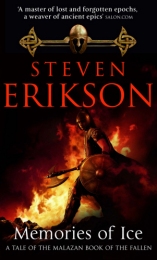 Third book in the series. I started reading it with very high expectations. I knew from forums’ discussions and reviews that this third book was considered the highest peak in the whole series. I came from the previous two that I loved and, especially, after being AWED by the three novellas of Bauchelain and Korbal Broach. Those that won me over and got my unconditional love for Erikson. The difference is that before I came to the books with expectations to match, after having read the novellas I’m now ready to put aside what “I’d like and expect to read” and just let Erikson bring me where he wants. I’ve learned to respect and admire his work and forget the pettish critical eye of the always skeptic.
Third book in the series. I started reading it with very high expectations. I knew from forums’ discussions and reviews that this third book was considered the highest peak in the whole series. I came from the previous two that I loved and, especially, after being AWED by the three novellas of Bauchelain and Korbal Broach. Those that won me over and got my unconditional love for Erikson. The difference is that before I came to the books with expectations to match, after having read the novellas I’m now ready to put aside what “I’d like and expect to read” and just let Erikson bring me where he wants. I’ve learned to respect and admire his work and forget the pettish critical eye of the always skeptic. This book collects at a (relatively) accessible price the three novellas that PS Publishing published separately. I didn’t know what to expect, how much they were connected to the bigger series, how relevant. If a significant effort with its own purpose or just a diversion intended for the most passionate readers who won’t miss even the minor works. Well, I don’t even know where to start with the praises because this isn’t simply a “worthy” read compared to the rest of the books, but may be as well the finest writing Erikson ever achieved. And by a good margin.
This book collects at a (relatively) accessible price the three novellas that PS Publishing published separately. I didn’t know what to expect, how much they were connected to the bigger series, how relevant. If a significant effort with its own purpose or just a diversion intended for the most passionate readers who won’t miss even the minor works. Well, I don’t even know where to start with the praises because this isn’t simply a “worthy” read compared to the rest of the books, but may be as well the finest writing Erikson ever achieved. And by a good margin. The novels are put in the book in the chronological order of the plot, but the second was actually written and published last. This is interesting to consider because it proves again Erikson’s growth as a writer. There’s a steady, definite improvement between the three novellas in the order they were written, so with the second representing the real peak.
The novels are put in the book in the chronological order of the plot, but the second was actually written and published last. This is interesting to consider because it proves again Erikson’s growth as a writer. There’s a steady, definite improvement between the three novellas in the order they were written, so with the second representing the real peak. It represents the high peak and the one case where I can say: there are no flaws.
It represents the high peak and the one case where I can say: there are no flaws. Erikson meets Pratchett. This novella reads like satire, with plenty of wit and paradoxical situations.
Erikson meets Pratchett. This novella reads like satire, with plenty of wit and paradoxical situations. Deadhouse Gates is the second volume in the “Malazan Book of the Fallen” ten volumes (now sixteen) planned series. The eighth, Toll the Hounds was recently released in UK.
Deadhouse Gates is the second volume in the “Malazan Book of the Fallen” ten volumes (now sixteen) planned series. The eighth, Toll the Hounds was recently released in UK. The story so far:
The story so far: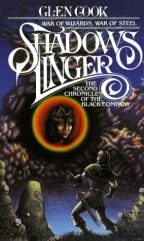 Second book of a trilogy, but also part of a series of ten books in total. I didn’t comment the first book, but I read it. It was wonderful.
Second book of a trilogy, but also part of a series of ten books in total. I didn’t comment the first book, but I read it. It was wonderful.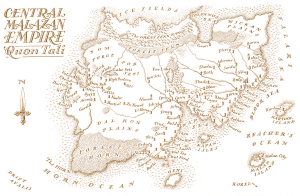 Steven Erikson shares the Malazan world with his friend and co-writer Ian Cameron Esslemont (ICE for short).
Steven Erikson shares the Malazan world with his friend and co-writer Ian Cameron Esslemont (ICE for short).